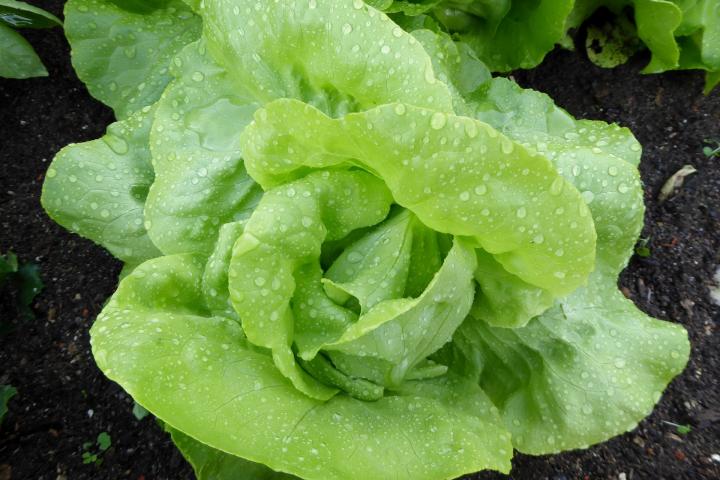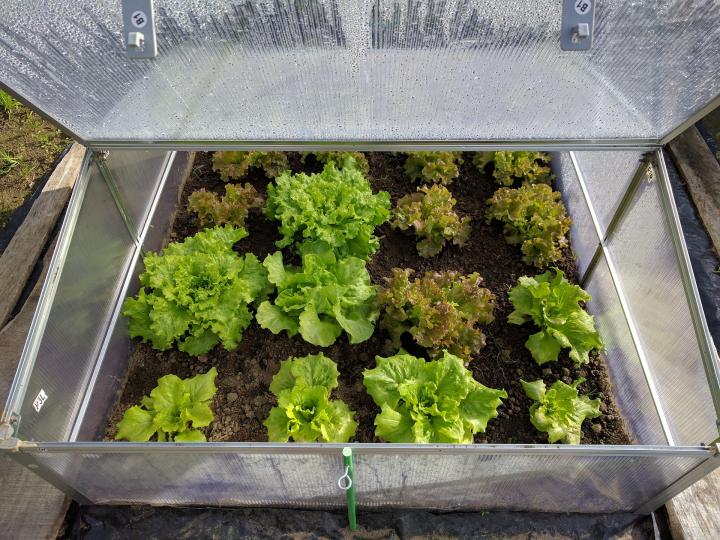If you haven’t tasted fresh homegrown lettuces, you’re missing out. They’re far superior to the store-bought alternatives and a great crop for beginner gardeners, too. Check out our Lettuce Growing Guide—plus, our new video on Top Tips for Perfect Lettuce Every Time!
About Lettuce
Lettuces are a cool-season crop, which means they fare best in cooler, more temperate conditions. Sow lettuce seeds directly in the soil nice and early, starting 2 weeks before your last spring frost. Continue to stagger seed sowing every couple of weeks until the weather gets hot. Start again toward fall, planting seeds 6 to 8 weeks before first fall frost.
Lettuces are a great leafy green because they grow quickly, produce for a long time, and are not very demanding as long as you keep the plants sufficiently watered. Plus, lettuce grows great in raised beds making it ideal for small spaces. Lettuces are perfect for containers, which can be placed on decks, patios, balconies, and porches.
See these clever tips and tricks to seeding lettuce from expert vegetable gardener, Ben!
When to Plant Lettuce
- Direct sowing in the garden is recommended as soon as the ground can be worked. Sow 2 to 4 weeks before your last spring frost date. Soil temperatures need to reach 40°F (4°C), though seeds germinate best at 55 to 65°F (13 to 18°C). Seedlings will typically emerge in 7 to 10 days.
- If you want an even earlier start, sow them under cover 4 to 6 weeks before your last frost with plenty of lights, such as indoors or in a greenhouse, hoop house or cold frame. If it’s fairly gloomy, you may get the best results by growing them under grow lights to start with.
- Nursery-bought lettuce transplants should be planted close to your last frost-free date. Transplants that were started indoors may be planted 2 to 3 weeks earlier after they are properly hardened off.
- You can help transplants along at the start of the season by covering them with a temporary cloche made from bottomless milk cartons or plastic bottles – demo of this. These will keep the chill off your seedlings just enough to help them acclimatize. Newly planted lettuces may also be helped with a simple covering of row cover or fleece.
- Continue sowing every few weeks to enjoy a steady stream of leaves; we suggest small sowings each time, so you’re not overwhelmed!
- In most regions, it’s possible to plant another crop of lettuce in the fall or even early winter. See our Planting Calendar for planting dates.
- Tip: To plant a fall crop, create cool soil in late August by moistening the ground and covering it with a bale of straw. A week later, the soil under the bale will be about 10°F (6°C) cooler than the rest of the garden. Sow a three-foot row of lettuce seeds every couple of weeks—just rotate the straw bale around the garden.

Choosing and Preparing a Planting Site
- Select a sunny spot for the best growth. Ideally, the plants should get at least 6 hours of sun per day, though lettuce will still grow if given less than that.
- The soil should be loose and drain well, so that it’s moist without staying soggy.
- To keep the soil fertile, work in composted organic matter about one week before you seed or transplant.
- Since the seed is so small, a well-tilled seedbed is essential. Stones and large clods of dirt will inhibit germination.
- Lettuce does not compete well with weeds. Spacing lettuce close together will help to control weeds.
- Rotating locations from year to year helps to reduce the occurrence of most diseases.
- Read more about preparing soil for planting.
How to Plant Lettuce
- Seeds should be planted 1/8 to 1/4 of an inch deep. Lettuce seeds need light to germinate, so don’t sow them too deep.
- Seedlings can be thinned when they have 3 to 4 true leaves. You can eat what you thin out, too.
- Transplants should have 4 to 6 mature leaves and a well-developed root system before being planting into the garden.
- For either seeded or transplanted lettuce, leave 12 to 15 inches between each planting row. Here are guidelines for different lettuce types:
- Loose-leaf lettuce: Plant or thin to 4 inches apart.
- Romaine (cos) and butterhead (loose-head, Bibb, Boston) lettuce: Plant or thin to 8 inches apart.
- Crisphead (iceberg) lettuce: Plant or thin to 16 inches apart.
- Water thoroughly at time of transplanting.
- Consider planting rows of chives or garlic between your lettuce to control aphids. They act as “barrier plants” for the lettuce.
- If you’d like to grow your lettuce inside your home, check out these tips for growing lettuce indoors.

How to Care for Lettuce
- Fertilize 3 weeks after transplanting. Lettuce prefers soil that is high in organic material, with plenty of compost and a steady supply of nitrogen to keep if growing fast. Use organic alfalfa meal or a slow-release fertilizer.
- Make sure the soil remains moist but not overly wet. It should drain well.
- Lettuce will tell you when it needs water. Just look at it! If the leaves are wilting, sprinkle them anytime, even in the heat of the day, to cool them off and slow down the transpiration rate. Using row covers can also help to keep lettuce from drying out in the sun.
- An organic mulch will help conserve moisture, suppress weeds, and keep soil temperatures cool throughout the warmer months.
- Weed by hand if necessary, but be careful of damaging your lettuce plants’ roots; they are shallow.
Bolting
- Bolting is a common problem that’s caused by warm temperatures (over 70°F / 20°C) or changes in day length. When a lettuce plant bolts, it starts to produce a central stem and seed stalk, and leaves take on a bitter flavor.
- To delay bolting, cover plants with a shade cloth so that they get filtered light. Be sure to maintain watering throughout the warmest parts of the growing season, too.
- Planning your garden so that lettuce will be in the shade of taller plants, such as tomatoes or sweet corn, may reduce bolting in the heat of the summer.

- Aphids
- Cutworms
- Earwigs
- Powdery Mildew
- Lettuce Mosaic Virus
- Slugs/Snails
- White Mold
- Whiteflies
- Woodchucks
- Rabbits
Some of our favorite varieties include:
- Crisphead: ‘Great Lakes’, ‘Ithaca’, ‘King Crown’, ‘Mission’, ‘Summertime’
- Romaine (Cos)/Butterhead: ‘Burpee Bibb’, ‘Cosmo Savoy’, ‘Green Towers’, ‘Little Gem’, ‘Paris White Cos’, ‘Parris Island’, ‘Valmaine’
- Loose-Leaf: ‘Black Seeded Simpson’, ‘Green Ice’, ‘Ibis’, ‘Lollo Rossa’, ‘Oak Leaf’, ‘Prizehead’, ‘Salad Bowl’, ‘Slobolt’
- Red Leaf: ‘New Red Fire’, ‘Red Sails’, ‘Ruby Red’ (Not recommended for hot weather areas; the red pigment absorbs more heat.)
…But there are so many more types of lettuce to explore!
Check out this video to find varieties of lettuce and salad greens that you can grow in containers for an urban garden!
How to Harvest Lettuce
- Lettuce should be harvested when full size, but just before maturity. The leaves taste best when they’re still young and tender.
- Before maturity, you can harvest leaf lettuce by simply removing outer leaves so that the center leaves can continue to grow.
- Butterhead, romaine, and loose-leaf types can be harvested by removing the outer leaves, digging up the whole plant, or cutting the plant about an inch above the soil surface. A second harvest is often possible when using the first or third methods.
- Crisphead lettuce is picked when the center is firm.
- Mature lettuce gets bitter and woody and will go bad quickly, so check your garden everyday for ready-to-harvest leaves.
- It’s best to harvest lettuce in the morning before leaves have been exposed to sun, as they will be the most crisp at this time.
- Put the harvested lettuce in cold water for a few minutes.
- Place the lettuce in a salad spinner or towel. Spin the spinner to remove water from the lettuce.
- As time passes and the plant loses vigor, you may be better off planting a second round of seeds than waiting for new leaves.
- Keep lettuce in the refrigerator for up to 10 days in a loose plastic bag.
- Lettuce leaves have wilted? Put the leaves in a bowl of cold water with ice cubes and soak for about 15 minutes.
Ready to see how it’s done? Check out this video demo on growing lettuce!
- Did you know that lettuce and sunflowers are relatives? They both belong to the Asteraceae (or “daisy”) family.
- “Lettuce is like conversation; it must be fresh and crisp, so sparkling that you scarcely notice the bitter in it.” –My Summer in a Garden, by Charles Dudley Warner, American writer (1829-1900)
- Eating lettuce for dinner can be calming and help to reduce stress.
- Embrace your leafy greens! Learn more about the health benefits of going green and how to grow other salad greens in your garden!
Lettuce makes the perfect base for any number of salads. Try these eight great salad recipes with your harvest!




